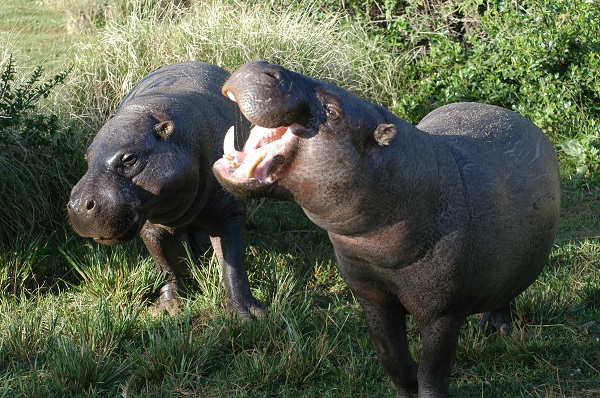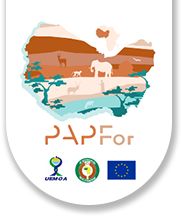Home / Guinean forests / Characteristics / The biodiversity / Species identity card / The pygmy hippopotamus
The pygmy hippopotamus
- Class : Mammifère
- Order : Artiodactyle
- Family : Hippopotamidés
- Genus : Choeropsis
- Specie: liberiensis
- Weight: about 200 kg, up to 275kg for males
- Size: up to 80 cm at the withers and 170cm length
- Diet : herbivore
- Habitat : wetlands and rivers of the dense humid forests of West Africa
- Discreet, solitary, semi-aquatic and nocturnal animal
- Lifespan (in captivity) : from 30 to 55 ans

An unusual species, emblematic of the forests of Upper Guinea
The pygmy hippopotamus (Choeropsis liberiensis) is a species of hippopotamus native to the forests and swamps of West Africa. It is the cousin of the much better known and larger so-called ‘amphibian’ hippopotamus.
The scientific species name means ‘from Liberia’, as that is where a large majority of them live. Smaller populations are also clustered near the Liberian border in Côte d’Ivoire, Guinea and Sierra Leone, making it one of the region’s iconic species. Old records show the species was also once present in Nigeria, but that population is now believed to be extinct.
It is considered one of the 10 species most in need of protection, to prevent its disappearance. See its identity sheet.
Some particularities
The skin of pygmy hippos secretes a protective substance that gives a pinkish tinge to their body and is sometimes called ‘blood sweat’, although it is neither sweat nor blood.
Pygmy hippos spend most of the day hiding in streams, emerging from the water at nightfall to feed. They use existing trails to move through the dense forest.
Sexual maturity for the pygmy hippopotamus occurs between three and five years. The gestation period varies from 190 to 210 days, and there is usually only one young per litter.
Since it is very difficult to observe this discreet and mainly nocturnal species, scientists study it mainly by exploiting its tracks and using camera-traps.
Danger of extinction
The International Union for the Conservation of Nature estimates that there are fewer than 3 000 pygmy hippos left in the wild (https://www.iucnredlist.org/species/10032/18567171).
The Convention on the International Trade in Endangered Species of Wild Fauna and Flora (CITES) lists it in Appendix 2 as a species that may be threatened by uncontrolled international trade and that must be covered by an export permit or re-export certificate (https://cites.org/fra/app/appendices.php).
Threats to the species are mainly habitat loss and fragmentation, as forests are cleared and converted to agricultural land. They are also threatened by poaching, hunting, natural predators and war.
The NGO Sylvatrop runs a conservation programme for the pygmy hippopotamus in Guinea.
The species survives in three landscapes supported by PAPFor: Gola-Foya, Wologizi-Wonegizi-Ziama and Taï-Grebo-Sapo. Among the most important protected areas for the conservation of the species are Tiwaï Island and Gola Rainforest NP (Sierra Leone), Gola Forest NP (Liberia), Ziama and Diecke (Guinea), Sapo NP (Liberia) and Taï NP (Côte d’Ivoire).

